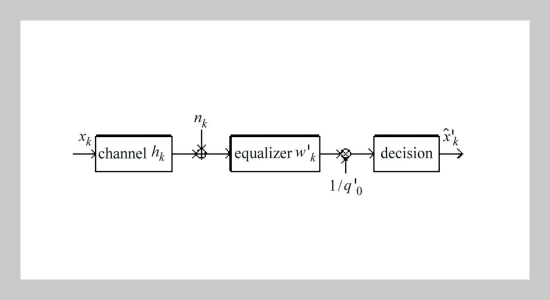REFERENCES
- [1] Proakis, J. G., Digital Communications, 4th ed. McGraw-Hill, New York (2001).
- [2] Gitlin, R. D., Hayes, J. F. and Weinstein, S. B., Data Communication Principles, Plenum (1992).
- [3] Haykin, S., Adaptive Filter Theory, 4th ed. PrenticeHall, Upper Saddle River, NJ (2002).
- [4] Saltzburg, B. R., “Intersymbol Interference Error Bounds with Application to Ideal Bandlimited Signaling,” IEEE Trans. Inform. Theory, Vol. IT-14, pp. 563�568 (1968).
- [5] Lee, E. A. and Messerschmitt, D. G., Digital Communications, 2nd ed. Kluwer, Boston, MA (1994).
- [6] Cioffi, J. M., Dudevoir, G. P., Eyuboglu, M. V. and Forney, Jr., G. D., “MMSE Decision-Feedback Equalizera and Coding-Part I: Equalization Results,” IEEE Trans. Commun., Vol. 43, pp. 2582�2594 (1995).
- [7] Lugannani, R., “Intersymbol Interference and Probability of Error in Digital Systems,” IEEE Trans. Inform. Theory, Vol. IT-15, pp. 682�688 (1969).
- [8] Ho, E. Y. and Yeh, Y. S., “A New for Evaluating the Error Probability in the Presence of Intersymbol Interference and Additive Gaussian Noise,” Bell Syst. Tech. J., Vol. 49, pp. 2249�2265 (1970).
- [9] Shimbo, O. and Celebiler, M., “The Probability of Error Due to Intersymbol Interference and Gaussian Noise in Digital Communication Systems,” IEEE Trans. Commun. Technol., Vol. COM-19, pp. 113�119 (1971).
- [10] Glave, F. E., “An Upper Bound on the Probability of Error Due to Intersymbol Interference for Correlated Digital Signals,” IEEE Trans. Inform. Theory, Vol. IT-18, pp. 356�363 (1972).
- [11] Yao, K., “On Minimum Average Probability of Error Expression for Binary Pulse-Communication System with Intersymbol Interference,” IEEE Trans. Inform. Theory, Vol. IT-18, pp. 528�531 (1972).
- [12] Yao, K. and Tobin, R. M., “Moment Space Upper and Lower Error Bounds Digital Systems with Intersymbol Interference,” IEEE Trans. Inform. Theory, Vol. IT-22, pp. 65�74 (1976).
- [13] Salz, J., “Optimum Mean-Square Decision-Feedback Equalization,” Bell Syst. Tech. J., Vol. 52, pp. 1341� 1373 (1973).
- [14] Chen, S., Mulgrew, B., Chng, E. S. and Gibson, G. J., “Space Translation Properties and the Minimum-BER Linear-Combiner DFE,” IEE Proc.-Commun., Vol. 145, pp. 316�322 (1998).
- [15] Chen, S. and Mulgrew, B., “Minimum-SER LinearCombiner Decision Feedback Equalizer,” IEE Proc. - Commun., Vol. 146, pp. 347�353 (1999).
- [16] Chen, S., Samingan, A. K., Mulgrew, B. and Hanzo, L., “Adaptive Minimum-BER Linear Multiuser Detection for DS-CDMA Signals in Multipath Channels,” IEEE Trans. Signal Process., Vol. 49, pp. 1240�1247 (2001).
- [17] Chen, S., Hanzo, L. and Mulgrew, B., “Adaptive Minimum Symbol-Error-Rate Decision Feedback Equalization for Multilevel Pulse-Amplitude Modulation,” IEEE Trans. Signal Process., Vol. 52, pp. 2092�2101 (2004).
- [18] Yeh, C.-C. and Barry, J. R., “Adaptive Minimum BitError Rate Equalization for Binary Signaling,” IEEE Trans. Commun., Vol. 48, pp. 1226�1235 (2000).
- [19] , “Adaptive Minimum Symbol-Error Rate Equalization for Quadrature-Amplitude Modulation,” IEEE Trans. Signal Process., Vol. 51, pp. 3263�3269 (2003).
- [20] Liu, H. Y. and Yen, R. Y., “Channel Equalization Using Biased and Unbiased Minimum Error Rate Criteria,” IEICE Trans. Fundamentals, Vol. E87-A, pp. 605�609 (2004).
- [21] Yen, R. Y., Liu, H. Y., Li, C. W. and Cheng, W. C., “The Adaptive MSINR Algorithm to Improve Error Rate for Channel Equalization,” Signal Processing, Vol. 86, pp. 1984�1991 (2006).
- [22] Yen, R. Y., “Stochstic Unbiased Minimum Mean Error Rate Algorithm for Decision Feedback Equalizers,” IEEE Trans. Signal Processing, Vol. 55, pp. 4758� 4766 (2007).
















